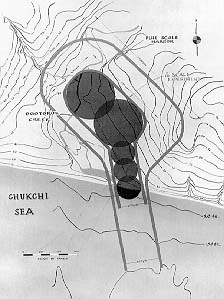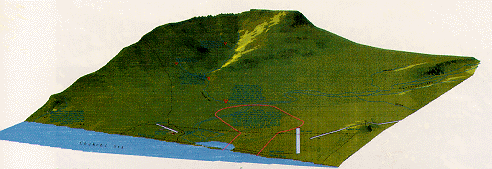Project Chariot
http://arcticcircle.uconn.edu/VirtualClassroom/Chariot/chariotindex4.html
In
1958, shortly after the start of Project Plowshare, Edward Teller and other
scientists at the Atomic Energy commission conceived the idea of using
atomic explosions to excavate a harbor in northwest Alaska. Other
projects considered were a new canal through Central America, a highway/railroad
cut in southern California and water storage reservoirs.
Project Chariot involved using
a series of atomic blasts to excavate a channel and turning basin to serve
as a deep water port in Northwest Alaska. The chosen site was a drainage
called Ogotoruk Creek on Cape Thompson. The site was north of Kotzebue,
between the villages of Point Hope and Kivalina. The AEC originally
claimed the goal of the project was the economic development of the area,
and that without economic justification it would not proceed, however
there was no need for a large port in that part of Alaska. No significant
reserves of minerals or oil were known to be in the area. The project
was meant to be a test of the new concept of “geographic engineering”.
In later phases of the project the AEC conceded that there was little economic
justification for the project, but they still planed to proceed with it
as an experiment. The project received enthusiastic support from
many civic and business leaders in Alaska. The villagers in Point
Hope and some scientists at The University of Alaska were somewhat skeptical.
A group of university scientists
raised some of their objections at AEC presentations in Fairbanks.
As a result the University was hired to carry out an extensive biological
study of the area to determine if and when the project could safely be
carried out. As the project progressed it became apparent to many
of the scientists that their data was being ignored or deliberately misused.
Several of the scientists, in alliance with the fledgling environmental
group Alaska Conservation Society started to speak out against the project.
The AEC presented the village
of Point Hope with extremely misleading information about the risks presented
by the atomic explosions. The people of Point Hope together with
The Association on American Indian Affairs and a grassroots church group
in New England also worked against the project. In 1962, largely
as a result of the efforts of these small groups, Project Chariot was
cancelled or as the AEC said “held in abeyance.” Had Project Chariot
been carried out at its smallest proposed size, approximately 200 times
as much radiation as was released at Chernobyl would have been released.



